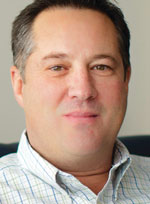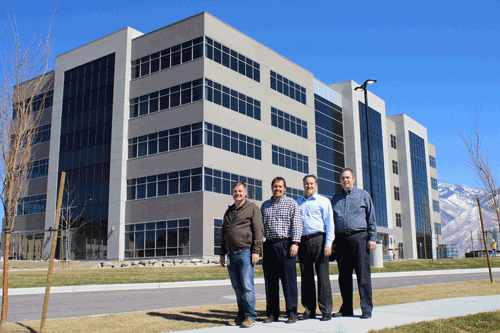In-Depth
StorageCraft's Growth Plan: Think Globally, Act Locally
While sticking to its roots in fast, local backup and recovery, Utah-based StorageCraft is investing aggressively in heavy-duty cloud disaster protection solutions and expanding its global footprint.
- By Scott Bekker
- March 30, 2015
Scott Barnes points across the Salt Lake Valley from StorageCraft Technology Corp.'s nearly complete, five-story headquarters in the direction of the nearby world-class colo facility that will be the primary U.S. site of the company's new backup and disaster recovery cloud. It's appropriate that Barnes, who is StorageCraft's CTO, and the other co-founders and senior executives of the company are wearing construction hardhats for a tour of the headquarters building on this unseasonably warm February day.
Meanwhile, the prolific alliance partner is finalizing a few more major partnerships, putting the finishing touches on a Windows version of the new snapshot driver and updating the StorageControl software for monitoring backups with management functionality, all of which should hit in the next few weeks and months. That all comes against a backdrop of aggressive domestic and international hiring.
With all that the channel-only vendor is building, shipping and doing right now, wearing a helmet seems like a good idea.
Local-First Philosophy
For a company investing heavily in cloud technology, it's a little surprising to hear company executives describe where cloud fits in disaster recovery.
"If you had to summarize what StorageCraft is about, we're a disaster recovery software company," begins Curt James, co-founder and vice president of marketing and business development, as he explains the philosophy behind the channel-focused company's recent investments. "You've got to have a decent backup, but you've got to be able to recover it. So I would say as a tagline, 'We're fast, reliable and flexible.' We've stayed on course with that from the very beginning. How do I get a server back online as quickly as possible?"
Where the conversation veers from currently fashionable spiels on Disaster Recovery as a Service is when James discusses the value of local. "Our philosophy has always been local first, for local recovery."
 "Our philosophy has always been local first, for local recovery."
"Our philosophy has always been local first, for local recovery."
Curt James, Co-Founder and VP of Marketing and Business Development, StorageCraft Technology Corp.
Heading for Linux
That local focus is probably the reason that, amidst all the change happening, StorageCraft executives seem most excited about the new SPX agent under development. Currently, StorageCraft loads a ShadowProtect agent on the Windows servers its software backs up. Usually those agents push backup data to the local server, NAS device or SAN, where StorageCraft ImageManager is running. ImageManager captures the sector-level, block-based snapshots sent by ShadowProtect from the production servers and keeps the full backup, as well as incrementals, and plugs those into staged virtual machines (VMs).
"If the system crashes, you don't have to go through that whole recovery process because you can have terabytes of information. You could just spin up the VM and you're ready to go. We started locally, and we have that option locally," James says.
SPX is an agent architecture to replace ShadowProtect. The agent carries the initials of the old brand, with the X standing for cross-platform. A Linux version was scheduled to ship by March 31, while the Windows version is expected to be ready by mid-May, along with updated ShadowControl management software to manage multi-platform backup and recovery environments.
The SPX agent will support more than a dozen Linux distributions, and executives have high hopes that the agent will open up the market to StorageCraft partners in two ways.
"What partners have been telling us is that we've always been a Windows-based company, but there have been deals that are majority Windows that the partners have been unable to land because even though the customer is only 10 percent Linux, they want one solution for the whole thing," says Mike Kunz, vice president of sales at StorageCraft. "We see it helping push additional growth in the Windows space, as well, because they'll be able to grab that entire site and bring them onboard."
 "There have been deals that are majority Windows that the partners have been unable to land because even though the customer is only 10 percent Linux, they want one solution for the whole thing."
"There have been deals that are majority Windows that the partners have been unable to land because even though the customer is only 10 percent Linux, they want one solution for the whole thing."
Mike Kunz, VP of sales, StorageCraft Technology Corp.
In addition to appealing to customers who don't want to deal with one backup and recovery solution for all their Windows servers and another solution for just a few Linux servers, Kunz believes the Linux support will remove another obstacle.
The all-Windows shop tends to be more of a staple of the small to midsize business (SMB) and lower midmarket. Expanding beyond that box into larger client sites requires a multi-platform solution.
"We also see as we bring on partners who are going after larger and larger companies, there's just a higher percentage of Linux in those. Some of our resellers have felt like they were a little capped with our products that we would only scale to a certain level. Now with the addition of Linux and the additional management capabilities, we're going to be able to scale to a much bigger site and allow them to expand where they can take solutions," Kunz says.
Big Cloud 2.0
The emphasis on local is far from exclusive for StorageCraft. The company has been enabling partners to offer off-site backup through various means for years, and has had a cloud service of its own for years.
"Recovery [should be] local, but the cloud is critical," James says. "With compliancy issues, all of those things, people want some kind of catastrophic failure solution. There's too much liability so they need to address that. It's kind of a natural progression, especially for managed services providers [MSPs], to have that add-on, premium managed service to offer depending on what verticals we're targeting. For health care it's critical, maybe government and some kinds of companies need to address that."
Because it was offering cloud backup for disaster recovery, StorageCraft executives long felt that they needed a more scalable and robust cloud offering if they were going to give partners what they needed for the future.
The result is the StorageCraft Cloud Solution, which was scheduled to launch March 31.
"As we looked at this current cloud and where we wanted to be in two, three, four, five years, we knew that we needed to change our foundation," says David McConkie, senior product manager at StorageCraft. "[We] said, 'OK, let's not just figure out how we can add additional rooms onto this existing foundation -- that's not quite where we want it to be. Let's start over.'"
McConkie describes the effort as taking the time to step back and really get a handle on where a backup and disaster recovery cloud needs to be. "Probably one of our largest teams over the last two to three years has been on cloud. And, frankly, what we're getting prepared to launch is probably our third or fourth stab at it in the last two-and-a-half years. We've looked at everything. We've looked at several types of solutions. We've built several proof of concepts and then gotten into them a little bit and said, nope, this has too many limitations. We've scrapped it, and started over," McConkie says.
An example of the type of problem StorageCraft set out to solve is the common limitation in current clouds when a user needs to resize a virtual disk locally and has no choice but to start over. "They can't continue to take snapshots of that VM with now a resized local disk and send that to the cloud. They have to delete their device in the cloud, request a C drive, grab that C drive, and then basically start over," McConkie says. "With the launch of our cloud we're going to support those VM resizings."
Some of the investments won't be visible to partners. "We really want our support department to have every single tool that they need to proactively support our MSPs and our end users," says McConkie, "so we've added all those controls. It's been more than just building a cloud. It's the whole infrastructure and support for that cloud."
Others investments will be visible. The primary StorageCraft U.S. datacenter is just a few miles away at the C7 Data Centers flagship facility, Granite Point II, a 95,000-square-foot Tier 3 facility. The cloud will use a secondary U.S. mirroring facility in Atlanta. StorageCraft also plans colocation facilities in Canada, the United Kingdom and Germany in order to fulfill those countries' legal requirements that data be stored locally.
"We've got thousands and thousands of hard drives over at C7 right now ready for our launch, a multi-petabyte cloud, just there ready to go. Your data goes in, it's stored on encrypted drives and your data is distributed across all of those hard drives," McConkie says.
The company chose to use Ceph, a free storage software platform that's designed for fault tolerance at exabyte scale on commodity hardware and is used for the Large Hadron Collider at CERN. "You might have a bit or two on this hard drive, a bit or two on this hard drive and multiple copies of your data in the cloud," McConkie says. "Even if somebody walked in, grabbed an entire server and walked out, there's no way they could recover your data because they would just have bits of it. The way that the Ceph system works is that we actually store multiple copies of your data in the cloud -- we only charge the client for one -- but you've got three copies of that data that's in constant communication with each other."
 [Click on image for larger view.] Storagecraft Technology Corp. co-founders Scott Barnes, Brandon Nordquist and Curt James, along with vice president of sales Mike Kunz, at the company’s new headquarters in Draper, Utah.
[Click on image for larger view.] Storagecraft Technology Corp. co-founders Scott Barnes, Brandon Nordquist and Curt James, along with vice president of sales Mike Kunz, at the company’s new headquarters in Draper, Utah.
StorageCraft's MSP and other partners will be able to offer three tiers of cloud service.
Cloud Basic will involve passing up ShadowProtect or SPX image files. In cases of a disaster wiping out servers and local backups, StorageCraft creates a bare metal restore drive for the customer and ships it in a Pelican case to the customer. Cloud Plus, the next level, adds to the basic service with the ability to do file and folder restores directly from the cloud.
Cloud Premium combines the previous two services with the ability to virtualize machines in the cloud through a direct browser integration. "For instance, here at StorageCraft, if we replicate all of our servers into the cloud, if our building burns down, with the click of a few buttons we can virtualize our entire network in the cloud in just a few minutes and have them fully up and networked. So it's a full duplication of your entire network," McConkie says.
Busting at the Seams
As StorageCraft cuts over its cloud customers to its new cloud and releases the Linux snapshot agent, the company's employees will be moving themselves across town to a new facility in Draper. Going from the 1990s feel of the office park headquarters building with its low ceilings to the new facility will be an adjustment.
The old building isn't big enough to accommodate all of the current StorageCraft Utah staff, and support staff are temporarily housed in another facility. The company has been in this position before, and not long ago. Three-and-a-half years ago, StorageCraft moved its headquarters across the parking lot and went on a hiring tear.
Constrained by space at that time to about 30 employees, StorageCraft started expanding as soon as the company moved and now has more than 200 employees in the two buildings in Draper.
Anticipating similar growth now, Barnes has planned in some headroom. In addition to the high ceilings and open floor plan with views of the surrounding mountains in the new, modern office building, there's some growing room. StorageCraft will take up three floors of the new building, which is in a hot technology area near an Ebay office and the U.S. National Security Agency's huge new datacenter. The other floors are occupied by short-term tenants, meaning that StorageCraft can grow to fit about 450 employees in the headquarters in the short term. Longer term, Barnes says the building can accommodate more than 700 people.
Internationally, StorageCraft is also expanding rapidly. An office in Cork, Ireland, which opened a year ago with one U.S. transplant, is now up to 30 people. A new office in Tokyo has eight employees. Meanwhile, the company's model of creating inside channel sales teams with systems engineers, accompanied by local representatives, who can meet with partners face-to-face in sales territories and countries, means the headcount is expanding beyond the offices.
Already the company's growth is straining parts of the plan in the Draper headquarters building. Kunz has been busy hiring inside sales reps and sales engineers. "We went over and put together our plans [for using space in the building] four or five months ago. Yesterday they told me here's where sales is going to be, and I got looking, and we don't fit. We've grown enough that the area they've allocated for me, for my inside channel team isn't big enough," he says with a laugh.
Undoubtedly, all the expansions in the product line -- starting to back up Linux servers and releasing a rearchitected and more robust cloud offering -- will bring challenges, as well. But they're the kinds of challenges any business owner welcomes -- the challenges that are created as you execute on an aggressive growth plan.